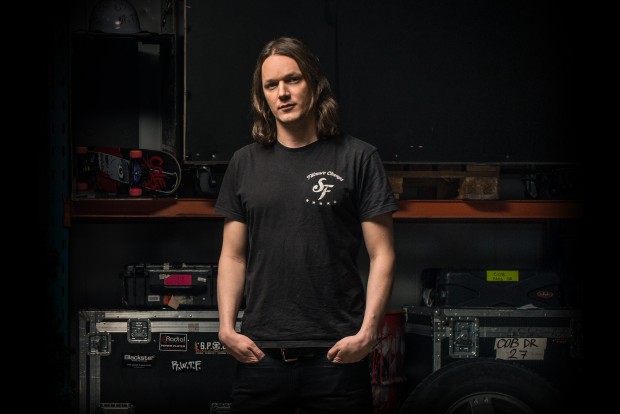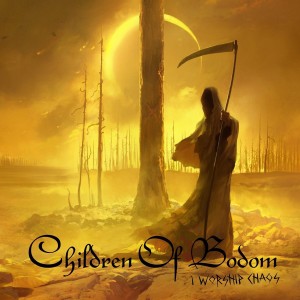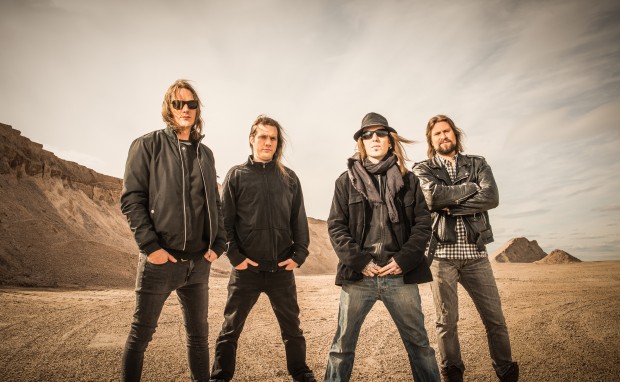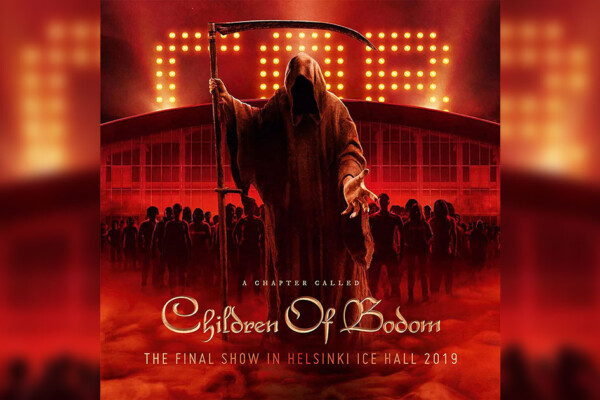I Worship Chaos: An Interview with Henkka Blacksmith

This year has been one of change for Finnish death metal outfit Children of Bodom. The band announced the departure of longtime guitarist Roope Latvala in May, leaving the group as a four-piece configuration. Their new album I Worship Chaos (due October 2nd) will be their first record created as a quartet, but their sound is just as huge thanks in part to bassist Henkka Blacksmith.
Blacksmith, aka Henkka Seppälä, joined the stalwart group in 1996 and has been featured on all eight of their studio albums. His monstrous bass tone has been featured prevalently throughout, though each each album has been an evolution in his sound. I Worship Chaos shows a steady and supportive side of his playing with rumbling bass underpinning the band’s thick texture.
We caught up with Blacksmith to get the story behind the new album, his evolved style of playing, how he makes his bass lines, and the band’s penchant for covering ’80s pop songs.
What is the overall idea behind the new album? What was the thinking going into it?
There’s never any thinking when we do albums. We always do them pretty much the same way since 1997. We just start to make music and the lyrics come afterwards. The music is always the first thing we do and this time it was the same. The only goal is to make good songs that everyone can be happy with. There’s nothing more deep than that.
So it’s really about the music, so there’s never really concept albums from Children of Bodom?
No, we just make songs. We make riffs and add melodies. It’s a really primitive way of making music, I guess [laughs].
The album art is pretty striking. What’s the story behind it?
 It has the Reaper, like we always do. We wanted to go monochromic with just one dominating color. We have pretty much gone through all the colors already [with our other albums]. We’d been thinking about yellow but didn’t think it could work, actually. Last winter I started to think of yellow album covers and Googled a lot of images. There were several that caught my attention and looked good. I talked with the guys and we decided to do it.
It has the Reaper, like we always do. We wanted to go monochromic with just one dominating color. We have pretty much gone through all the colors already [with our other albums]. We’d been thinking about yellow but didn’t think it could work, actually. Last winter I started to think of yellow album covers and Googled a lot of images. There were several that caught my attention and looked good. I talked with the guys and we decided to do it.
The artist we found was very cool. He made a couple sketches and that was it. It has an apocalyptic feeling in it. We tried to have the same shape of Lake Bodom and the tree that supposedly standing at the murder site, that’s the one in the middle of the cover. So it’s supposed to be the lake that’s dried out.
Overall the album sounds like you have a little bit rounder tone as opposed to some of the past releases where you had a gnarlier bite.
Yeah, it’s been changing from album to album. I think it’s more round now; it’s not as distinct as it was on the previous album. But anyway, the idea is the same to have it distorted and distinctive bass sound.
Do you have a favorite track from the album?
My favorite track would be “Morrigan,” the first one we released. It’s got my favorite bass line in there, too, during the “C” part that I wrote with [guitarist Alexi Laiho]. It reminds me of some old early ’90s death metal song that has this very simple and low and repeating bass line. Then a little bit of it is kind of like following the guitars that are in the main riff. It’s a pretty cool combination.
How do you decide when you’re going to lock in with the drummer versus go with the guitar riff? Do you have a formula for that or do you feel it out for every song?
I feel it. Usually when the drums are super fast, there’s no need to even try to go along with the drums. Then I usually stick with the guitars. But when there’s a chance that I can groove with the bass drum, then I’ll usually stick with that.

Bodom’s sounds is pretty layered, like a wall of sound. Does that force you to lay back in your bass lines?
Yeah, it doesn’t force me but I’ve gone that way lately. The more albums we make, the more I try to be in the background with the drums and try to glue it together in a way, even though it doesn’t need any glue. But I try to keep it more simple than I used to. I used to play like a third guitarist, but now I’m more like a bass player.
You’ve also brought back producer Mikko Karmila.
We’ve had him for maybe five albums now. He’s the guy that records, like the studio engineer. He has a saying [that] he won’t hesitate to tell you if you’re playing shitty or not. So in a way, he’s producing as well.
It’s important for someone to tell you that, right?
Yeah. So we like to call him a producer, too, though he is not a producer like Rick Rubin. We know him very well and everyone is comfortable working with him. We trust his filter, so whenever something passes his filter we can be sure that it was a good take.
What was the recording process like for you?
We have our own place where everybody has their own stuff there. I had my own gear there, with an Orange 4×10 in an isolated room. Then I had my regular rig in the studio room.
Can you give us a rundown of your gear?
I have an Ampeg SVT-4 Pro, then the Orange cabinet. I also used a distortion pedal by a small Finnish company called Darkglass Electronics. That was the first time I used it. My technician always hooks me up with the new stuff.
You guys always do some pretty out there covers, and this time around the bonus songs include “Danger Zone” by Kenny Loggins. That’s one that people would probably not expect… How did that come about?
Some of the guys are big ’80s and early ’90s fans, and “Danger Zone” represents that era. Of course, everybody knows the song. It’s a cool track, but it was surprisingly difficult to arrange. A lot of times when you pick up these songs, you’ve heard them a thousand times. When you start to actually listen to them for how the parts go, they’re actually usually more complex than you would think. Even though that song is super simple, when you break it down it’s actually not that simple.
You’re about to hit the road in support of the new album, but mostly in Europe and Asia. Any plans to come to North America next year?
Yeah, first we’ll go to China, then we’ll do a festival in Tokyo, Japan, and then we go to Australia with Megadeth. [As far as North America], we’ve already set up the date for the 70,000 Tons of Metal Cruise that’s happening in early February. Then we’ll keep on touring the states, so I think it will be February and March. I don’t have any dates yet, but that’s when we’ll be in the States.

